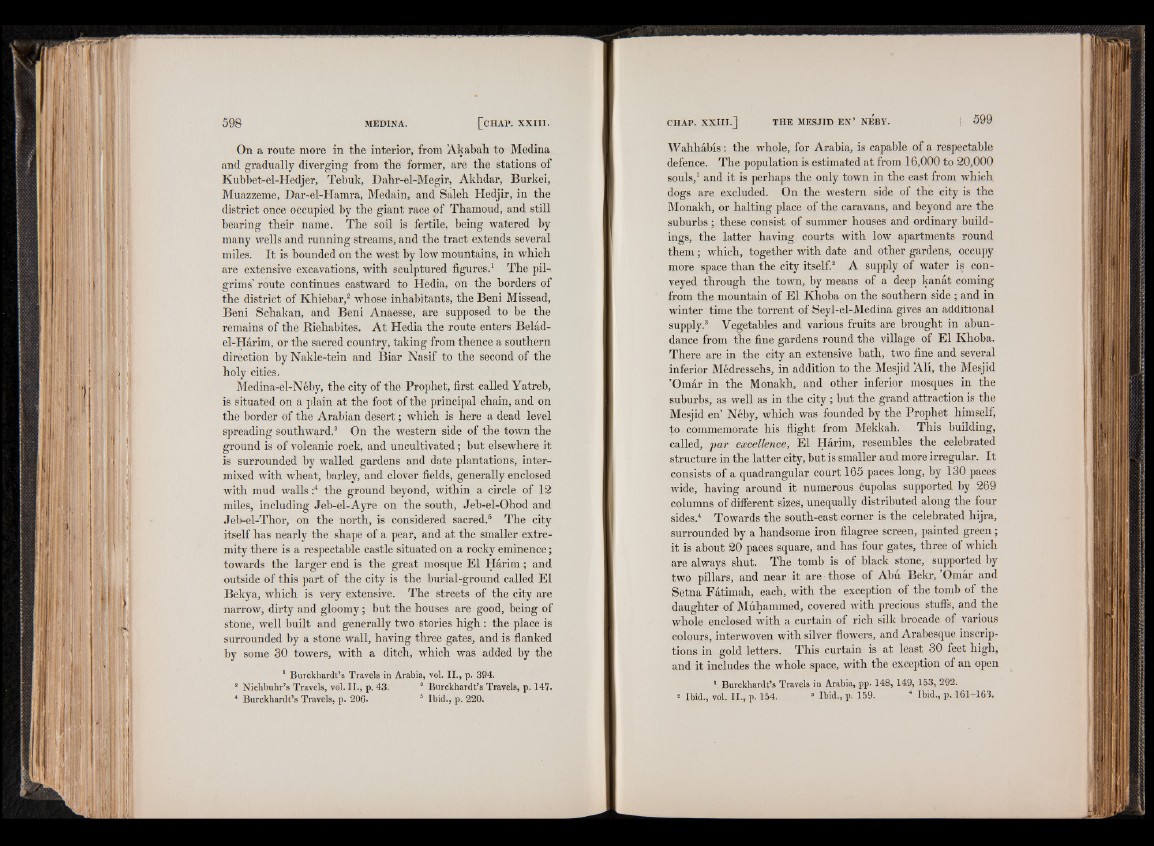
On a route more in the interior, from Akabah to Medina
and gradually diverging from the former, are the stations of
Kubbet-el-Hedjer, Tebuk, Dahr-el-Megir, Akhdar, Burkei,
Muazzeme, Dar-el-Hamra, Medain, and Saleh Hedjir, in the
district once occupied by the giant race of Thamoud, and still
hearing their name. The soil is fertile, being watered by
many wells and running streams, and the tract extends several
miles. It is bounded on the west by low mountains, in which
are extensive excavations, with sculptured figures.1 The pilgrims’
route continues eastward to Hedia, on the borders of
the district of Khiebar,2 whose inhabitants, the Beni Missead,
Beni Schakan, and Beni Anaesse, are supposed to he the
remains of the Riehabites. At Hedia the route enters Belad-
el-Harim, or the sacred country, taking from thence a southern
direction by Nakle-tein and Biar Nasif to the second of the
holy cities.
Medina-el-Neby, the city of the Prophet, first called Yatreb,
is situated on a plain at the foot of the principal chain, and on
the border of the Arabian desert; which is here a dead level
spreading southward.3 On the western side of the town the
ground is of volcanic rock, and uncultivated; but elsewhere it
is surrounded by walled gardens and date plantations, intermixed
with wheat, barley, and clover fields, generally enclosed
with mud walls :4 the ground beyond, within a circle of 12
miles, including Jeb-el-Ayre on the south, Jeb-el-Ohod and
Jeb-el-Thor, on the north, is considered sacred.5 The city
itself has nearly the shape of a pear, and at the smaller extremity
there is a respectable castle situated on a rocky eminence;
towards the larger end is the great mosque El Harim ; and
outside of this part of the city is the burial-ground called El
Bekya, which is very extensive. The streets of the city are
narrow, dirty and gloomy; but the houses are good, being of
stone, well built and generally two stories high : the place is
surrounded by a stone wall, having three gates, and is flanked
by some 30 towers, with a ditch, which was added by the
1 Burckhardt’s Travels in Arabia, vol. II., p. 394.
8 Niehbuhr’s Travels, vol. II., p. 43. 8 Burckhardt’s Travels, p. 147.
4 Burckhardt’s Travels, p. 206. 5 Ibid., p. 220.
Wahhabis: the whole, for Arabia, is capable of a respectable
defence. The population is estimated at from 16,000 to 20,000
souls,1 and it is perhaps the only town in the east from which
dogs are excluded. On the western side of the city is the
Monakh, or halting place of the caravans, and beyond are the
suburbs; these consist of summer houses and ordinary buildings,
the latter having courts with low apartments round
them; which, together with date and other gardens, occupy
more space than the city itself.2 A supply of water is conveyed
through the town, by means of a deep kanat coming
from the mountain of El Khoba on the southern side ; and in
winter time the torrent of Seyl-el-Medina gives an additional
supply.3 Vegetables and various fruits are brought in abundance
from the fine gardens round the village of El Khoba.
There are in the city an extensive bath, two fine and several
inferior Medressehs, in addition to the Mesjid Ali, the Mesjid
’Omar in the Monakh, and other inferior mosques in the
suburbs, as well as in the city ; but the grand attraction is the
Mesjid en’ Neby, which was founded by the Prophet himself,
to commemorate his flight from Mekkah. This building,
called, par excellence, El Harim, resembles the celebrated
structure in the latter city, but is smaller and more irregular. It
consists of a quadrangular court 165 paces long, by 130 paces
wide, having around it numerous cupolas supported by 269
columns of different sizes, unequally distributed along the four
sides.4 Towards the south-east corner is the celebrated hijra,
surrounded by a handsome iron filagree screen, painted green;
it is about 20 paces square, and has four gates, three of which
are always shut. The tomb is of black stone, supported by
two pillars, and near it are those of Abu Bekr, Omar and
Setna Fatimah, each, with the exception of the tomb of the
daughter of Muhammed, covered with precious stuffs, and the
whole enclosed with a curtain of rich silk brocade of various
colours, interwoven with silver flowers, and Arabesque inscriptions
in gold letters. This curtain is at least 30 feet high,
and it includes the whole space, with the exception of an open
| Burckharilt’s Travels in Arabia, pp. 148, 149, 153, 292.
8 Ibid., vol. II., p. 154. 3 Ibid., p. 159. 4 Ibid., p. 161-163.